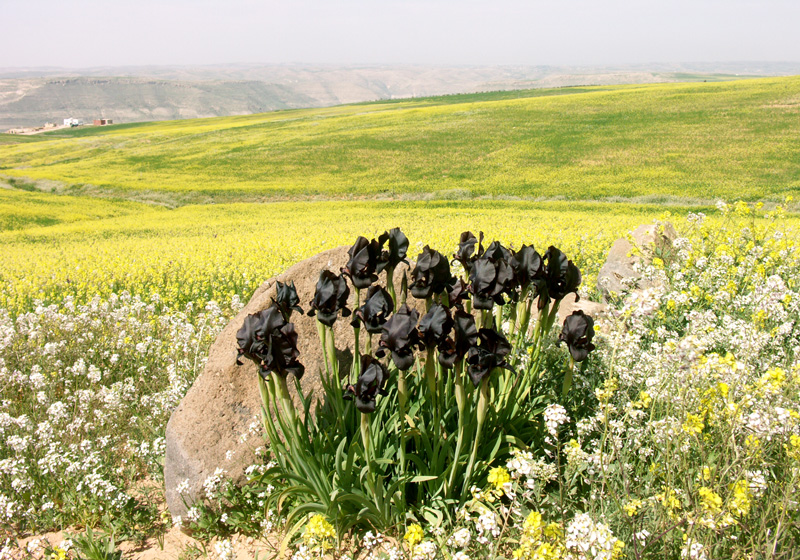Black on Black
Black is beautiful. Nature has been very stringent in using black on flowers. It is strange to see black in bloom, but when it occurs, the result is of utmost elegance. The Black Iris, Jordan’s national flower, has adapted to a landscape of ample sun. It has evolved in a harsh environment, wind-blown, to acquire a unique color matching the black eyes of remote shepherds. “Iris Nigricans”, the scientific name of Jordan’s Black Iris, suggests its color. But Jordan has nine other different kinds of iris, so far identified in the wild. Some are extremely rare, and one kind - Iris Vartanii - is now extinct.
Vartanii Iris had flowers in light blue; it was recorded in the mountains of Salt as a species new to Jordan. Dr. Dawud Al Eisawi mentions in his book, “Wild Flowers of Jordan”, how the habitat of this flower was destroyed leading to its disappearance. If you spot some iris on the mountainsides overlooking the Jordan Valley, in regions north of Amman, such flowers would be either Jil’ad Iris -Iris Atrofusca- in the mountains between Salt and Jerash, or Purple Iris -Iris Atropurpuraea- if found around Irbid, Ajloun, or near Um Qais.
To the south of Amman, you would find the real Black Iris, our national pride, in landscapes between Madaba and Karak. Its entire flower is dipped in black, as a round sphere as big as 12 to 15cm in diameter; the flower has a glossy lustrous finish, shimmering in the blowing wind. At the base of this sphere, three petals curve downwards, each showing a patch of velvet of the deepest black. The contrast of gloss with velvet is extremely beautiful, black on black, accentuating the mass of the flower, its sharp lines and its delicate transparent veins.
It you spot iris to the south of Tafileh, then it would be the Petra Iris - Iris Petrana - which is similar to Black Iris but is found in groups, 20 or more flowers, in simultaneous bloom. It is dark violet to chocolate brown, and has a large flower on a relatively shorter stem sprouting from waxy sword-like leaves.

Closer to ruins, and often in graveyards, you might spot the German Iris - Iris Germanica - which can grow up to 80cm. with blue-violet flowers on branching stalks. A colony of this flower can be seen at the site of Nabi Hood south of Jerash.
Jordan has a smaller, more delicate, Post Iris - Iris Postii - with tiny flowers. This iris grows almost everywhere, from the mountains to the east of the Rift Valley and all the way to the eastern desert.
There are two more rare kinds of iris: Edom iris - Iris Edomensis - which is a very strange flower, spotted, jagged, and sits on a bunch of green-silver leaves without much of a stem. This flower, which looks like some exotic insect, is very difficult to find. I had the chance to spot it only once, at the cliff overlooking the village of Dana. It grows in the land of the Edomites, which gave it the name. The second is desert iris - Iris Aucheri - with flowers in white, pink, yellow, violet or blue. It grows in the desert wadies and the land of Karak.
Most of the nine kinds of wild iris in Jordan are endangered. Iris is a victim of its charm, and a victim of “development” that destroys its fragile habitat and brings it to extinction.
Now is the season of Black Iris, it is a short season if you miss it you have to wait for another year. Some of the best destinations are drives on village roads on the Karak plateau, between Karak and the escarpment of Wadi Mujib to the north. This destination needs a full day. For half a day destination, your best bet would be village roads south of Madaba, on the way to Makawir, and eastwards towards villages of Irainba Al Aarbyeh and Irainba Al Shargyeh, around Umm el Rasas, and eastwards till the Desert Highway. Don’t pick wild iris, it is an endangered plant, its rhizome is very much on the surface of soil, and is often uprooted easily with the stem. Black Iris will not live in house-gardens, due to difference of environment and soil conditions.